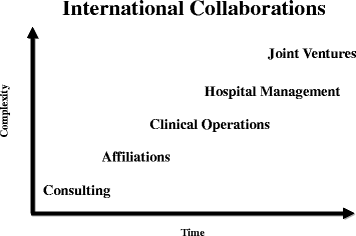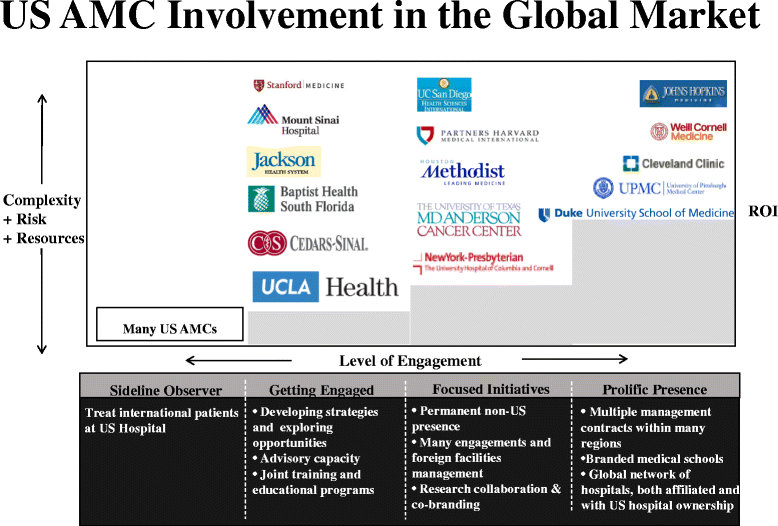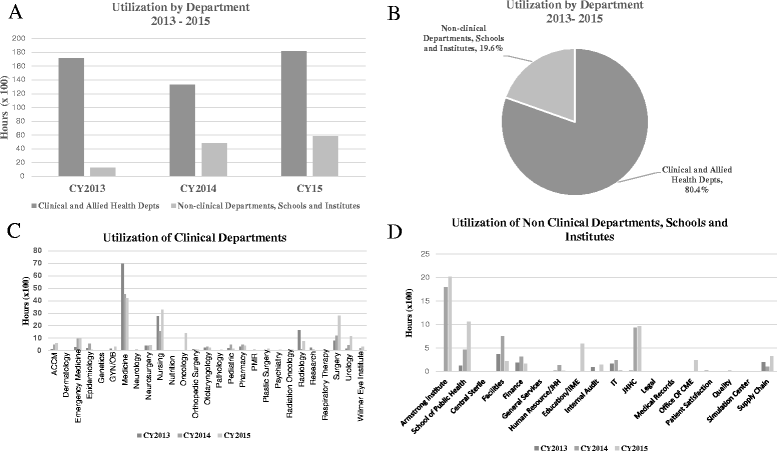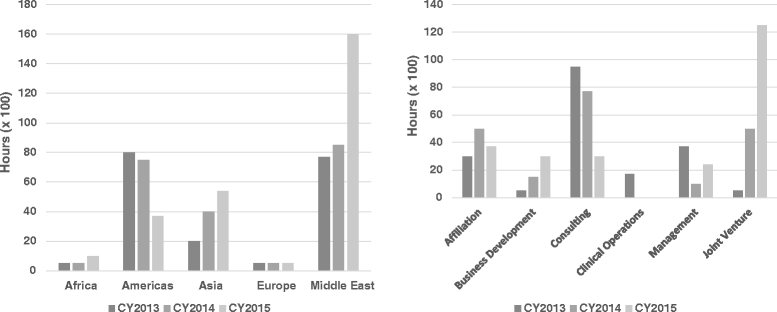Global collaborative healthcare: assessing the resource requirements at a leading Academic Medical Center
- PMID: 28931438
- PMCID: PMC5607605
- DOI: 10.1186/s12992-017-0298-5
Global collaborative healthcare: assessing the resource requirements at a leading Academic Medical Center
Abstract
Introduction: Academic Medical Centers ("AMCs") have served as a hub of the United States ("US") health system and represented the state-of-the art in American health care for well over a century. Currently, the global healthcare market is both massive and expanding and is being altered by the unprecedented impact of technological advances and globalization. This provides AMCs a platform to enter into trans-national collaborative partnerships with healthcare organizations around the world, thus providing a means to deliver on its promise globally while also expanding and diversifying its resources. A number of leading US AMCs have engaged in global collaborative healthcare, employing different models based on services offered, global distribution, and inclination to assume risk. Engaging in these collaborations requires significant effort from across the health system, and an understanding of the resources required is paramount for effective delivery and to avoid overextension and diversion from the primary mission of these organizations. The goal of this paper is to discuss the role of US AMCs in this current global healthcare landscape and to also investigate our institutional faculty and staff resource requirements to support the operating model.
Methodology: We extracted and retrospectively analyzed data from the JHI Global Services database for a 3-year period (Jan, 2013-Dec, 2015) to determine total utilization (hours and full time equivalent (FTE)), utilization by profession, and clinical and non-clinical areas of expertise.
Results: JHI utilized on average 21,940 h annually, or 10.55 FTEs of faculty and staff subject matter experts. The majority of the hours are for work performed by physician faculty members from 23 departments within the School of Medicine, representing 77% percent or on average 16,894 h annually. Clinical and allied health departments had an average annual utilization of 17,642 h or 7.8 FTEs, while non-clinical departments, schools and institutes averaged 4298 h or 1.9 FTEs, representing 80.4% and 19.6% respectively.
Conclusion: We found that significant human resources are required within a broad range of AMC subject matter expertise across multiple disciplines, and that with adequate forecasting AMCs can successfully engage in these collaborations while continuing to fulfill their core mission.
Keywords: Global collaborative health; Globalization; Resource utilization academic medical centers.
Conflict of interest statement
Consent for publication
Not applicable.
Competing interests
The authors declare that they have no competing interests.
Publisher’s Note
Springer Nature remains neutral with regard to jurisdictional claims in published maps and institutional affiliations.
Figures





Similar articles
-
The Harvard Medical School Academic Innovations Collaborative: transforming primary care practice and education.Acad Med. 2014 Sep;89(9):1239-44. doi: 10.1097/ACM.0000000000000410. Acad Med. 2014. PMID: 25006712
-
Japan as the front-runner of super-aged societies: Perspectives from medicine and medical care in Japan.Geriatr Gerontol Int. 2015 Jun;15(6):673-87. doi: 10.1111/ggi.12450. Epub 2015 Feb 5. Geriatr Gerontol Int. 2015. PMID: 25656311
-
Reengineering academic medical centers: reengineering academic values?Acad Med. 1996 Oct;71(10):1033-43. doi: 10.1097/00001888-199610000-00008. Acad Med. 1996. PMID: 9177635
-
The "for-benefit" academic medical center: a solution for survival.Acad Med. 2015 May;90(5):599-602. doi: 10.1097/ACM.0000000000000583. Acad Med. 2015. PMID: 25426740 Review.
-
The house of gastrointestinal medicine: how academic medical centers can build a sustainable economic clinical model.Clin Gastroenterol Hepatol. 2013 Nov;11(11):1370-3. doi: 10.1016/j.cgh.2013.08.003. Clin Gastroenterol Hepatol. 2013. PMID: 24139339 Review.
Cited by
-
Global Development of Research on Anorectal Malformations over the Last Five Decades: A Bibliometric Analysis.Children (Basel). 2022 Feb 14;9(2):253. doi: 10.3390/children9020253. Children (Basel). 2022. PMID: 35204973 Free PMC article.
-
Global trend of nondrug and nonsedativehypnotic treatment forinsomnia: a bibliometric study.J Tradit Chin Med. 2024 Jun;44(3):595-608. doi: 10.19852/j.cnki.jtcm.20240408.002. J Tradit Chin Med. 2024. PMID: 38767645 Free PMC article. Review.
-
A scientometric analysis of neuroblastoma research.BMC Cancer. 2020 May 29;20(1):486. doi: 10.1186/s12885-020-06974-3. BMC Cancer. 2020. PMID: 32471384 Free PMC article.
References
-
- Association of American Medical Colleges . Advancing the Academic Health System for the Future: A Report from the AAMC Advisory Panel on Healthcare. 2014.
Publication types
MeSH terms
LinkOut - more resources
Full Text Sources
Other Literature Sources
Medical
Molecular Biology Databases
Research Materials

